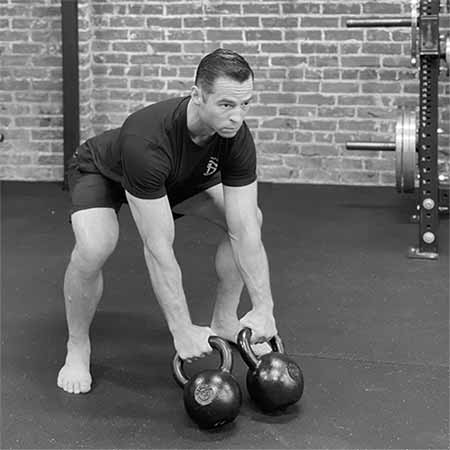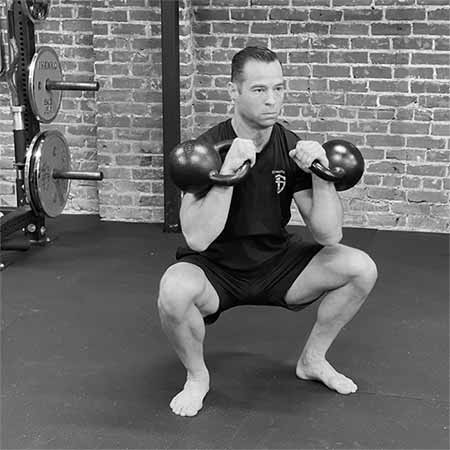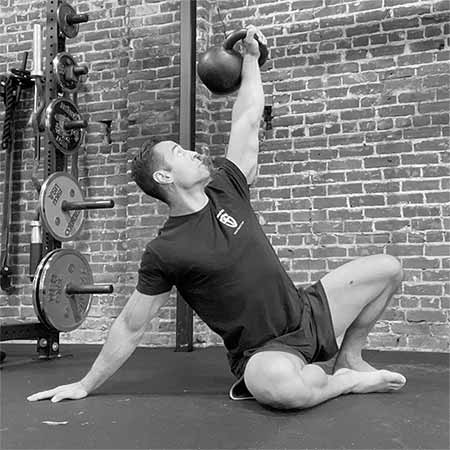There are times in life where your circumstances do not allow for much training. I am in one of those times as I write this. The only way for me to allocate an hour at a time to train would be to cut into my sleep, which would be a poor trade off considering the mental focus and physical energy I need for other higher priority tasks, not to mention trying to keep my immune system strong because risks of Covid are still present. That said, completely skipping training is not an option either as I need it for both physical and mental reasons. The compromise I decided to make is to get in at least an hour per week of training despite how full my plate is. Below is the plan I designed to accomplish this. Should you find yourself in a similar situation I hope it proves helpful.
The Groundwork
Before diving into the plan, it would be good to outline a few parameters. First, this is not a long-term training template. It is a short-term “Band-Aid” that is meant to get you through unusually difficult time constraints, preferably lasting less than a month. Second, from a time-management standpoint I decided the only realistic way for me to get training in would be a hard cap of 15-minute sessions (yes, 15 minutes total, start to finish). For this reason, I chose to use only equipment that requires no setup: kettlebells and a pullup bar. Barbells will have to wait until more time is available. Third, I drafted the plan to include movements that I (and most people) can jump right into without a significant warm-up. Again, because with only 15-minute to train a lot of things don’t make the cut, and a warm-up is one of those things. To quote Pavel, “The first step of prioritizing is deprioritizing.” That said, if you are in a position where you might use this plan, then you are undoubtedly stressed out and trying to even think about training is difficult, so I recommend to start each session with a set of 50 jumping jacks to serve as a small physical warm-up, and more importantly to help you “flip the switch” mentally to get into training mode.

The Details
The plan involves a total of one hour per week of training: 15 minutes done four times per week. Each of the six primary kettlebell exercises (the ones found in the SFG Level I certification) are used, offering a fairly even balance of grinds and ballistics. The plan also uses two pullup / chin-up sessions. Since the whole point of this template is to get you through a temporary period of a chaotic schedule, just get in the sessions when you can and don’t stress about which session goes on which day. The end result will be keeping your kettlebell skills sharp and maintaining your strength and endurance during a brief period where it would otherwise be difficult to train.
Session 1:
Complex of Double Kettlebell Cleans, Military Presses, and Front Squats
Set your timer to beep every three minutes. On each beep, perform a complex of cleans, presses, and squats (all the cleans first, followed by all the presses, followed by all the squats, then park the kettlebells). Rest actively (walk around) for the remainder of the 3-minute period. When the timer beeps again, do another identical complex. Repeat this process for five series (3-minute rounds x 5 series = 15 minutes).

I chose a pair of kettlebells that allowed five repetitions of each exercise: five double cleans, five double presses, and five double front squats. If you don’t have a pair of kettlebells light enough to do that, then sets of three or four repetitions of each exercise would be fine. Again, we’re going for “good enough” and not “perfect” for the time being. If you only have one kettlebell and not double, then do all the reps on your left side, then immediately match that on the right side. The single kettlebell will be less systemic stress because it is overall less weight, but you’ll also get a lot less rest because the sets will take twice as long. Again, it may not be perfect, but it is good enough.
Session 2:
One-Arm Swings and Chin-Ups
Grab a kettlebell you use for one-arm swings (probably what you use for Kettlebell Simple & Sinister) and do ten sets of ten in an every-minute-on-the-minute (EMOM) fashion. To clarify, minute one is ten swings with the left hand, minute two is ten swings with the right hand, and repeat for a total of ten minutes, or 100 swings. As usual, walk around and rest actively between efforts. After the swings are done, rest for three or four minutes (keep your timer going to keep track) and then finish the session with one single set of chin-ups. For the chin-ups, choose a number of reps that is difficult, but not maximum. Something around 80% of your max should be about right. If you are still building towards your first chin-up, then some alternatives would be a flexed-arm hang for about 80% of as long as you can, or a set of ten inverted rows on a pair of rings or suspension trainer. If you don’t have anything of the sort (pullup bar, rings, etc.) then a set of pushups that matches the effort level above will suffice for now.
Session 3:
Get-Ups and Snatches
This session will follow a similar format to Session 2 from above. Use one kettlebell for today: one you choose for snatches (this is usually lighter than you can do for get-ups). Set your timer for EMOM as you did with Session 2. Your first ten minutes are get-ups: minute one on the left, minute two on the right, and repeat until you have completed five on each side. Once the get-ups are done, rest for about three minutes, and then do one single set of snatches with that same kettlebell. For the snatches, do one long set with a single hand switch: about 80% of your maximum reps on the left-hand side, then a swing switch to get it to your right hand where you will then match that number. I recommend using a kettlebell that allows 20-25 repetitions per hand, of course meaning you’ll be doing 40-50 consecutively. If you are newer to snatches or for some reason high rep snatches are not a good fit for you, then feel free to replace them with a set of 50 reps of hand-to-hand swings instead.

Session 4:
Two-Arm Swings and Chin-Ups
This session is identical to Session 2 as far as format: ten sets of ten swings performed EMOM, rest 3-4 minutes, then one set of chin-ups at about 80% max. I do recommend two changes compared to Session 2, though. First, today you’ll do two-arm swings instead of one-arm; feel free to use a heavier kettlebell if you have one available. Second, use a different grip for your chin-ups (if you did the first day underhand, then today do something else, such as overhand, parallel grip, on rings, etc.). The same alternatives to chin-ups can be used as in session 2 if that makes sense for your circumstances.

Final Thoughts
Use this template for one to four weeks to maintain your strength, endurance, skills, and your sanity during unusually busy and stressful periods of your life. Hopefully by the end of that period your schedule will have calmed down and you can resume training as normal.










This really covers a lot! Why could you not do this indefinitely with light weeks and heavy weeks? It seems to fit with G. Nuepert “Strength Shortcuts.”
This is great Tony, thanks for sharing!
Glad you find it helpful!
Great article Tony, my wife is expecting our 2nd daughter soon and with an 18 month gap to the first daughter we’ll be busy and I’ll probably use this plan (or a variant of it) for the first 2-3 months.
Glad to hear it will be helpful for your situation!
Just what I was looking for. Simple, effective, and quick. Thanks for posting this.
For an over 50’s like me looks like a great, simple format. Why wouldn’t you want to use something like this longer than 4 weeks?
Great question. I’m in the 50’s, as well, and realizing that I can still get a great workout by doing less.
That said, a lot of the kettlebell programs I’ve seen, such as Neupert’s excellent KB Giant, seem to run for 4 weeks and then switch to another program. Not sure why. Maybe something to do with adaptation and muscle growth?
Hopefully, someone with knowledge on this will comment.
Hi Tim, for a variety of reasons this would not really be a sustainable plan IMO. One of the reasons is that for long term sustainability you need to wave the load (ideally both with volume and intensity), and this plan has little ability to do that. It served me well for a short period while my schedule was chaotic, but I do not recommend it as a long term solution.
This articles came at the perfect time! Thanks for putting this together, I can’t wait to get after it.
Fantastic! I’m glad it is helpful
Mike Mentzer, Pete Cisco, and every strongman pre 1940 actively trained very briefly. They would have often considered 15min to be a looong time.
Say we’re doing legs and abs in one session; 1-12x20R cossack squats to positive failure, then rest pause reps to failure, immediately followed by negatives…Super Set…1-12x20R weighted squats to positive failure, rest pauses till failure, dump weight and continue rest pause, then an iso hold anywhere in your rom. Catch your breath and do 1-12x20R calf raises, then rest pauses, negatives, and an iso hold. This entire Heavy Duty session was two work sets and approximately 6-8min. Add in abs in the same fashion immediately after and you have maybe 10-12min.
This only works when using the highest possible intensity you can muster, however do not do another session, even other body parts, till at least the 4th day after. Watch your strength, muscle size/density/tonality skyrocket while bolstering conditioning and achieving ultimate recovery!
Question: Just curious, on the first complex, why are the exercises done sequentially as three stand alone movements for all reps rather than as a giant set, clean, press, squat 5 times per three minute interval?
Is there some physiological advantage such as cumulative fatigue or some other reason?
Thanks!
Hi Albert, a “complex” means doing all of the exercises in a row without setting the kettlebell(s) down in between. So you’ll do 5 cleans, 5 presses, 5 squats all in a row, and then set the KB’s down only after all 15 reps are completed (you do not set them down in between exercises). Hopefully that helps clarify.
Tony, I think he means: why break the clean, press, and squat up into groups of 5, respectively, instead of doing a clean, press, and squat together in that order and repeat 5 times.
Yes Adam, that is what I meant.
This would be called a “Chain” which is a common alternative to a “Complex.” If you have three exercises (call them A, B, and C) and were to combine them doing three repetitions of each then examples would be:
Chain = ABC-ABC-ABC
Complex = AAA-BBB-CCC
Both are fine, and in many cases you are just splitting hairs doing one vs. another. Many people gravitate towards complexes because you tend to finish them a little faster, especially with double bells where you often adjust foot position between exercises. When doing a total of 15 reps in a chain fashion with doubles that can be quite a few adjustments of foot position, so many people prefer to just do them as a complex.
At the same time, if someone wanted to do them as a chain that would be fine too. I suspect most people would need to go a little lighter for this particular chain compared to if they did it as a complex.
Great work mate. I love minimalist as I have to train before work and get up early. No thinking just doing….
Thank you! I’m glad it is helpful.
Tony, you really have a knack for breaking things down so clearly and simply! Excellent article and I’m sure it’ll be a valuable reference!
Thank you Chris! I appreciate the compliment 🙂 I hope that most people don’t find themselves with schedules like this often, but it DOES happen once in a while, so I hope the info is helpful.